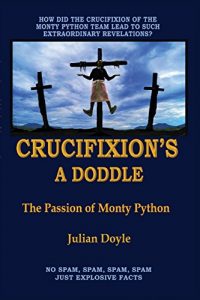As Julian Doyle, the editor of Monty Python's film Life of Brian, watched the comedy teams attempt to be crucified, for the end of their film, he began to notice something was seriously wrong. Checking for images of the crucified Jesus, he found none. The first appearing nearly 400 years after the event. But, not only were there no images of Jesus but not one of anyone else being crucified. And it was not until the first image appeared in 420 AD that the vertical cross replaced the original symbol for Christianity, which was the X shaped Chi-Rho. Our well-known image was clearly an invention by commissioned artists well after the actual event. And that is what Doyle had spotted on the set of Life of Brian, that crucifixion could not, and does not, work, and in this book he describes why.
With further research, he began to notice contradictions within the Biblical text about the death of Jesus, leading him to the shocking possibility that maybe Pontius Pilate did not crucify Jesus after all as all the evidence seemed to suggest that Jesus lived for a decade after Pilate left Judea. Now in this true life detective story Doyle astonishingly uncovers who was the real killer of Jesus Christ.
Behind his jovial and playful style, Julian Doyle conceals a rapier wit with which he cuts and slashes his way through the whole of the crucifixion story with expert analysis, bringing clarity to the Gospel and revealing for the first time a way of understanding what may be the true story of Jesus.
Leading Python Terry Jones has described Doyle as a polymath, and it is this extraordinary range of knowledge - coupled with a curious and accessible approach - that has helped lead him to his discoveries. Remarkable, challenging and possibly very naughty indeed, Crucifixion's a Doddle is a must-read for Python fans as well as anyone with an inquiring mind.In Crucifixion’s a Doddle, the irrepressible Doyle uses evidence to form his persuasive case; such as the fact that no image of Jesus on a cross appeared for 300 years after the event was alleged to have taken place, and that the images that did appear were likely an invention by commissioned artists at the time to explore the likelihood that the story told for centuries may not be as accurate as previously thought.
Behind his jovial and playful style, Julian Doyle conceals a rapier wit with which he cuts and slashes his way through the whole of the crucifixion story with expert analysis, bringing clarity to the Gospel and revealing for the first time a way of understanding what may be the true story of Jesus. Leading Python Terry Jones has described Doyle as a polymath, and it is this extraordinary range of knowledge - coupled with a curious and accessible approach - that has helped lead him to his discoveries. Remarkable, challenging and possibly very naughty indeed, Crucifixion’s a Doddle is a must-read for Python fans as well as anyone with an inquiring mind."
With further research, he began to notice contradictions within the Biblical text about the death of Jesus, leading him to the shocking possibility that maybe Pontius Pilate did not crucify Jesus after all as all the evidence seemed to suggest that Jesus lived for a decade after Pilate left Judea. Now in this true life detective story Doyle astonishingly uncovers who was the real killer of Jesus Christ.
Behind his jovial and playful style, Julian Doyle conceals a rapier wit with which he cuts and slashes his way through the whole of the crucifixion story with expert analysis, bringing clarity to the Gospel and revealing for the first time a way of understanding what may be the true story of Jesus.
Leading Python Terry Jones has described Doyle as a polymath, and it is this extraordinary range of knowledge - coupled with a curious and accessible approach - that has helped lead him to his discoveries. Remarkable, challenging and possibly very naughty indeed, Crucifixion's a Doddle is a must-read for Python fans as well as anyone with an inquiring mind.In Crucifixion’s a Doddle, the irrepressible Doyle uses evidence to form his persuasive case; such as the fact that no image of Jesus on a cross appeared for 300 years after the event was alleged to have taken place, and that the images that did appear were likely an invention by commissioned artists at the time to explore the likelihood that the story told for centuries may not be as accurate as previously thought.
Behind his jovial and playful style, Julian Doyle conceals a rapier wit with which he cuts and slashes his way through the whole of the crucifixion story with expert analysis, bringing clarity to the Gospel and revealing for the first time a way of understanding what may be the true story of Jesus. Leading Python Terry Jones has described Doyle as a polymath, and it is this extraordinary range of knowledge - coupled with a curious and accessible approach - that has helped lead him to his discoveries. Remarkable, challenging and possibly very naughty indeed, Crucifixion’s a Doddle is a must-read for Python fans as well as anyone with an inquiring mind."



